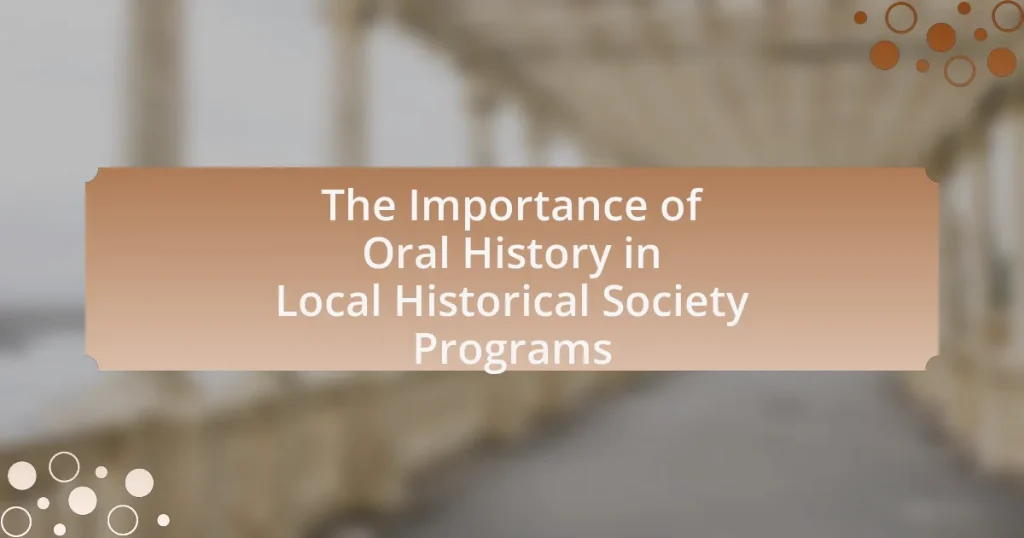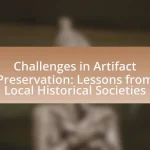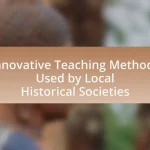The article focuses on the significance of oral history within local historical society programs, emphasizing its role in capturing personal narratives that enhance community history and cultural preservation. It outlines various methods for collecting oral histories, such as interviews and workshops, and discusses how these narratives provide unique insights into local events and social dynamics, particularly from marginalized perspectives. Additionally, the article addresses the challenges faced by historical societies in implementing oral history projects, including funding and engagement issues, while highlighting best practices for training, ethical considerations, and the use of technology to promote and preserve these valuable narratives.
What is the significance of oral history in local historical society programs?
Oral history is significant in local historical society programs because it captures personal narratives and experiences that enrich the understanding of community history. These firsthand accounts provide unique insights into local events, cultural practices, and social dynamics that are often absent from traditional historical records. For instance, oral histories can reveal the perspectives of marginalized groups, ensuring a more inclusive representation of the past. Additionally, studies have shown that oral history projects foster community engagement and intergenerational connections, as participants share their stories and learn from one another. This method of preserving history not only documents the past but also strengthens community identity and continuity.
How does oral history contribute to the preservation of local culture?
Oral history significantly contributes to the preservation of local culture by capturing and transmitting the lived experiences, traditions, and values of community members. This method allows for the documentation of unique narratives that may not be recorded in written history, ensuring that diverse voices and perspectives are included. For instance, oral histories can reveal local customs, dialects, and historical events from the viewpoint of those who experienced them, thereby enriching the cultural tapestry of a community. Research indicates that communities that actively engage in oral history projects often see a revitalization of cultural practices and a strengthened sense of identity among residents, as evidenced by initiatives like the Oral History Association’s projects that promote local storytelling and heritage preservation.
What methods are used to collect oral histories in local communities?
Methods used to collect oral histories in local communities include interviews, focus groups, and community workshops. Interviews are typically conducted one-on-one, allowing for in-depth conversations that capture personal narratives and experiences. Focus groups gather multiple participants to discuss specific themes, fostering a collective memory and diverse perspectives. Community workshops engage residents in storytelling activities, encouraging participation and collaboration in the oral history process. These methods are effective in preserving local culture and history, as evidenced by projects like the Library of Congress’s American Folklife Center, which emphasizes the importance of community involvement in documenting oral histories.
How do oral histories enhance the understanding of local events?
Oral histories enhance the understanding of local events by providing personal narratives that capture the lived experiences of individuals within a community. These narratives offer unique insights into the social, cultural, and emotional contexts surrounding historical events, which often go unrecorded in traditional historical accounts. For example, oral histories can reveal the perspectives of marginalized groups, thereby enriching the overall historical narrative and fostering a more inclusive understanding of local history. Studies have shown that communities that engage in oral history projects often report a deeper connection to their past, as these stories help to humanize historical events and create a shared sense of identity among residents.
Why is oral history considered a valuable resource for historical research?
Oral history is considered a valuable resource for historical research because it captures personal experiences and perspectives that are often absent from traditional historical records. This method provides unique insights into the social, cultural, and emotional contexts of historical events, allowing researchers to understand the lived experiences of individuals. For instance, oral histories can reveal the nuances of community life during significant events, such as wars or migrations, which are not always documented in written sources. Additionally, oral history can help preserve the voices of marginalized groups, ensuring that diverse narratives are included in the historical record. This approach has been validated by numerous studies, including the work of historians like Alessandro Portelli, who emphasized that oral testimonies can challenge and enrich established historical narratives by providing alternative viewpoints and personal accounts.
What unique perspectives do oral histories provide compared to written records?
Oral histories provide unique perspectives by capturing personal experiences, emotions, and cultural nuances that written records often overlook. These narratives reflect the lived realities of individuals, offering insights into social contexts, community values, and historical events from a subjective viewpoint. For instance, oral histories can reveal the impact of significant events, such as wars or migrations, on personal lives, which may not be detailed in official documents. This depth of understanding enhances historical narratives by incorporating diverse voices and experiences, thereby enriching the overall historical record.
How can oral histories fill gaps in the historical narrative?
Oral histories can fill gaps in the historical narrative by providing personal accounts and perspectives that are often overlooked in traditional historical records. These narratives capture the experiences of individuals from diverse backgrounds, including marginalized communities, thereby enriching the overall understanding of historical events. For instance, oral histories can reveal the social, cultural, and emotional dimensions of events like migration, war, or civil rights movements, which are frequently absent from written documents. Research conducted by the Oral History Association highlights that oral histories contribute to a more inclusive historical record by documenting voices that might otherwise remain silent, thus ensuring a more comprehensive representation of the past.
What challenges do local historical societies face in implementing oral history programs?
Local historical societies face several challenges in implementing oral history programs, including limited funding, lack of trained personnel, and difficulties in reaching diverse community members. Limited funding restricts the resources available for recording, archiving, and promoting oral histories, which can hinder the quality and scope of the programs. Additionally, many societies may not have staff or volunteers with the necessary skills in interviewing techniques, audio-visual technology, or archival practices, leading to inconsistent or poorly executed projects. Furthermore, engaging a diverse range of participants can be challenging due to language barriers, cultural differences, or a lack of awareness about the importance of oral history, which can result in underrepresentation of certain groups in the historical narrative.
How can local historical societies overcome barriers to collecting oral histories?
Local historical societies can overcome barriers to collecting oral histories by implementing targeted outreach strategies and utilizing technology. Effective outreach can involve building relationships with community members, hosting events to raise awareness, and collaborating with local organizations to identify potential interviewees. For instance, societies can engage with schools, libraries, and community centers to promote the importance of oral histories, thereby increasing participation.
Additionally, employing technology such as digital recording devices and online platforms can streamline the collection process, making it more accessible for both interviewers and narrators. Research indicates that using user-friendly recording tools can enhance participation rates, as individuals may feel more comfortable sharing their stories in a familiar environment. By combining these approaches, local historical societies can effectively address challenges related to accessibility, engagement, and resource limitations in collecting oral histories.
What training is necessary for volunteers and staff involved in oral history projects?
Volunteers and staff involved in oral history projects require training in interview techniques, ethical considerations, and archival practices. Training in interview techniques equips participants with skills to ask open-ended questions and facilitate engaging conversations, which is essential for gathering rich narratives. Understanding ethical considerations, such as informed consent and the respectful treatment of interviewees, ensures that the rights and dignity of participants are upheld. Additionally, training in archival practices is crucial for the proper documentation, preservation, and accessibility of recorded histories, which supports the long-term value of oral history projects.
How can technology aid in the preservation and sharing of oral histories?
Technology aids in the preservation and sharing of oral histories by providing tools for recording, storing, and disseminating these narratives. Digital recording devices, such as smartphones and audio recorders, enable high-quality capture of interviews, while software applications facilitate easy editing and enhancement of audio and video files. Cloud storage solutions allow for secure archiving of these recordings, ensuring they are accessible for future generations. Additionally, online platforms and social media enable broader sharing of oral histories, reaching diverse audiences and fostering community engagement. For instance, projects like StoryCorps utilize technology to collect and share personal stories, demonstrating the effectiveness of digital tools in preserving cultural heritage.
What ethical considerations must be taken into account in oral history projects?
Ethical considerations in oral history projects include informed consent, confidentiality, and the potential impact on participants and communities. Informed consent ensures that interviewees understand the purpose of the project and how their narratives will be used, which is crucial for respecting their autonomy. Confidentiality protects sensitive information shared during interviews, fostering trust between the interviewer and the participant. Additionally, the potential impact on communities must be considered, as narratives can influence public perception and historical record. These ethical guidelines are supported by the Oral History Association’s Principles and Best Practices, which emphasize the importance of ethical conduct in preserving the integrity of oral history.
How do consent and privacy issues affect the collection of oral histories?
Consent and privacy issues significantly impact the collection of oral histories by determining the ethical and legal frameworks within which these narratives are gathered. Researchers must obtain informed consent from participants, ensuring they understand how their stories will be used, which fosters trust and encourages participation. Additionally, privacy concerns necessitate careful handling of sensitive information, as individuals may share personal experiences that could affect their reputations or relationships. For instance, the American Historical Association emphasizes the importance of safeguarding participants’ identities and stories, particularly when dealing with marginalized communities. This adherence to consent and privacy not only protects individuals but also enhances the credibility and integrity of the oral history project.
What guidelines should be followed to ensure respectful representation of interviewees?
To ensure respectful representation of interviewees, it is essential to prioritize their dignity and agency throughout the interview process. This includes obtaining informed consent, allowing interviewees to share their stories in their own words, and ensuring that their perspectives are accurately represented without distortion. Respectful representation also involves being sensitive to the cultural and personal contexts of the interviewees, which can be supported by conducting thorough background research on their experiences. Furthermore, it is important to provide interviewees with the opportunity to review and approve the final content before publication, ensuring that they feel comfortable with how their narratives are presented. These guidelines are supported by best practices in oral history, which emphasize ethical considerations and the importance of collaboration between the interviewer and the interviewee.
How can local historical societies effectively utilize oral history in their programs?
Local historical societies can effectively utilize oral history in their programs by systematically collecting, preserving, and sharing personal narratives from community members. This approach enriches the historical record by capturing diverse perspectives and experiences that traditional documentation may overlook. For instance, oral histories can provide insights into local events, cultural practices, and social changes, thereby enhancing educational programs and exhibitions. Research indicates that oral history projects foster community engagement and intergenerational dialogue, as seen in the work of the Oral History Association, which emphasizes the value of personal stories in understanding history. By integrating oral history into their initiatives, local historical societies can create a more inclusive and dynamic representation of their community’s past.
What are the best practices for integrating oral history into educational programs?
The best practices for integrating oral history into educational programs include developing clear objectives, engaging with the community, training educators, and ensuring ethical considerations. Establishing clear objectives helps define the purpose of the oral history project, aligning it with curriculum goals. Engaging with the community fosters collaboration and enriches the narratives collected, making them more relevant to students. Training educators equips them with the necessary skills to effectively teach and facilitate oral history projects, enhancing student learning experiences. Ethical considerations, such as obtaining informed consent and respecting the privacy of interviewees, ensure that the oral histories are collected and presented responsibly. These practices are supported by research indicating that well-structured oral history projects can significantly enhance students’ understanding of historical contexts and personal narratives, as evidenced by studies from the Oral History Association.
How can oral histories be used to engage the community in local history?
Oral histories can engage the community in local history by capturing personal narratives that reflect the unique experiences and perspectives of community members. These narratives provide a rich, human dimension to historical events, making them more relatable and accessible to the public. For example, local historical societies can organize storytelling events where residents share their experiences related to significant local events, fostering a sense of connection and belonging. Research shows that communities involved in oral history projects report increased civic engagement and a stronger sense of identity, as these projects encourage dialogue and collaboration among diverse groups.
What role do oral histories play in exhibitions and public presentations?
Oral histories serve as vital components in exhibitions and public presentations by providing personal narratives that enrich the understanding of historical events. These firsthand accounts offer unique perspectives that often complement traditional historical records, allowing audiences to connect emotionally with the subject matter. For instance, oral histories can reveal the lived experiences of individuals during significant events, such as wars or social movements, thereby humanizing history and making it more relatable. Research indicates that incorporating oral histories into exhibitions increases visitor engagement and fosters a deeper appreciation for the complexities of the past, as evidenced by studies showing that audiences retain information better when it is presented through personal stories rather than just facts and figures.
How can local historical societies promote their oral history collections?
Local historical societies can promote their oral history collections by utilizing digital platforms and community engagement initiatives. By creating accessible online archives, societies can reach a broader audience, allowing individuals to explore oral histories from anywhere. Additionally, hosting community events, such as storytelling nights or workshops, can foster local interest and participation, encouraging residents to share their own stories and connect with the collections. Research indicates that community involvement significantly enhances the visibility and relevance of historical collections, as seen in the success of programs like the Oral History Association’s initiatives, which emphasize local engagement and digital accessibility.
What strategies can be employed to increase public awareness of oral history projects?
To increase public awareness of oral history projects, local historical societies can implement targeted outreach campaigns that utilize social media, community events, and partnerships with educational institutions. Social media platforms allow for the sharing of engaging content, such as video snippets of oral histories, which can reach a wider audience. Community events, such as storytelling nights or exhibitions, provide opportunities for direct engagement and foster interest in local history. Collaborating with schools and universities can also enhance visibility, as students can participate in projects, thereby promoting intergenerational dialogue and learning. These strategies have been shown to effectively raise awareness and participation in oral history initiatives, as evidenced by successful programs in various communities that have seen increased engagement through similar methods.
How can social media be leveraged to share oral histories with a wider audience?
Social media can be leveraged to share oral histories with a wider audience by utilizing platforms that facilitate storytelling, engagement, and community building. These platforms, such as Facebook, Instagram, and TikTok, allow users to post video clips, audio recordings, and written narratives, making oral histories accessible to diverse demographics. For instance, the use of hashtags can increase visibility, while live streaming events can engage audiences in real-time discussions about historical narratives. Research indicates that social media campaigns can significantly enhance the reach of cultural content; for example, a study by the Pew Research Center found that 69% of adults in the U.S. use social media, providing a vast audience for shared stories.
What practical tips can local historical societies follow to enhance their oral history programs?
Local historical societies can enhance their oral history programs by implementing structured interview guidelines, training volunteers, and utilizing technology for recording and archiving. Structured interview guidelines ensure consistency and depth in the narratives collected, which can lead to richer historical insights. Training volunteers equips them with the necessary skills to conduct interviews effectively, fostering a respectful and engaging environment for interviewees. Utilizing technology, such as digital recording devices and online archiving platforms, facilitates easier access to recorded histories and preserves them for future generations. These practices are supported by the National Park Service’s guidelines on oral history, which emphasize the importance of preparation and preservation in effective oral history projects.















